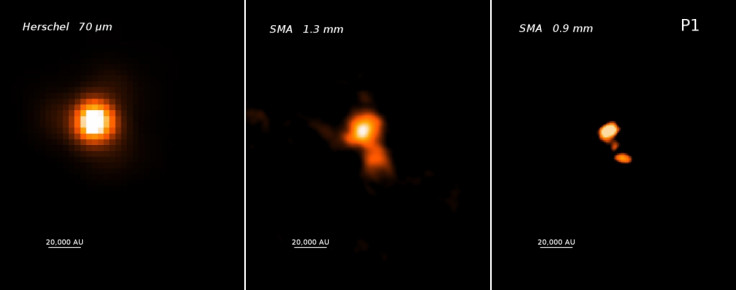Huge Stars In Space: Telescope Images Reveal How They Grow From Cosmic Seeds

Images from the Smithsonian Submillimeter Array telescope have provided a detailed insight into how cosmic seeds can grow into gigantic stars.
The images have captured images of stellar nurseries within the Snake nebula, which expands across 100 light years of space and is located around 11,700 light years from Earth.
Ke Wang, the author of the study at the Harvard-Smithsonian Center for Astrophysics, said: "To learn how stars form, we have to catch them in their earliest phases, while they're still deeply embedded in clouds of gas and dust, and the SMA is an excellent telescope to do so."
In images from NASA's Spitzer Space Telescope the Snake nebula appears as a dark tendril across space, targeted because it shows the potential to form many massive stars (stars heavier than 8 times our Sun).

The team studied two specific spots within the Snake nebula, called P1 and P6. In those areas a total of 23 cosmic "seeds" were discovered. These are eventually expected to turn into one or a cluster of stars. The seeds weigh between 5 and 25 times the mass of the Sun and the SMA telescope images also reveal the differing ages of the seeds.
The data, obtained by the Harvard-Smithsonian Center for Astrophysics, reveals stars are born in groups. Qizhou Zhang, of the CFA and the co-author of the study said "high-mass stars form in villages" in what he called a "family affair".

It was originally thought that stars with a large mass are formed in singular cores which weigh at least 100 times the mass of the sun, yet the information reveals this is not the case.
The research showed the two nebular areas had broken up into individual star seeds earlier in the star formation process than scientists originally believed. In addition, bipolar outflows revealed other signs of active, ongoing star formation.
The findings are set to be published in the Monthly Notices of the Royal Astronomical Society.
In December 2013, the SMA telescope peered into the star-forming region called W49A. It shines 100 times brighter than the Orion nebula, but is obscured by dust. The telescope revealed an active star formation in the region, which is located about 36,000 light-years away from Earth. It revealed an active star formation process, where stars are created 100 times faster than in our own galaxy.
This week, NASA revealed its Kepler telescope had discovered 715 previously unknown planets outside our solar system, increasing the number of planets discovered in the galaxy to about 1,700.
© Copyright IBTimes 2024. All rights reserved.







